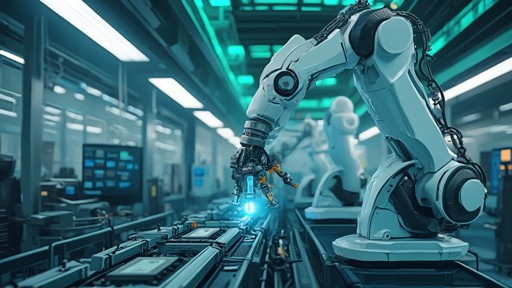Introduction
Robotic Process Automation (RPA) is transforming businesses by offering increased efficiency and precision. This article explores the benefits, key concepts, and challenges of robot automation, as well as best practices for implementation. With the adoption of automation technologies on the rise, companies are investing in intelligent solutions to improve productivity and image.
From selecting the right automation platform to creating a proof of concept and implementing bots, organizations can streamline operations and enhance efficiency. The integration of artificial intelligence and machine learning further refines the automation process, opening up new possibilities for innovation. As various industries embrace automation, the article highlights use cases and future trends, emphasizing the transformative power of robotics and automation in shaping the future of work.
Benefits of Robot Automation
Robotic Process Automation (RPA) is revolutionizing the way businesses operate, offering a new horizon of efficiency and precision. Through the use of software robots or ‘bots’, RPA enables the simulation and implementation of actions across software or data platforms, previously carried out by humans. These bots are capable of handling a variety of tasks including data entry, transaction processing, and managing workflows. Through this advanced technology, systems are interconnected, liberating employees from mundane tasks and enabling them to engage in more strategic roles.
The effect of such mechanization is deep, as proven by Millennium Recycling, a leader in material recovery. They have adopted cutting-edge technologies to enhance their operations, showcasing the potential of RPA. In the same way, St. James Winery has embraced technological advancements to uphold its position as a leading winery that consistently wins gold medals, proving that even conventional sectors can reap the rewards of contemporary progress.
Recent reports by the International Federation of Robotics indicate a surge in the deployment of industrial robots, with around 3.5 million units worldwide, valued at approximately 15.7 billion US dollars. This trend is not limited to manufacturing; the service industry has witnessed a significant increase in the use of chatbots, virtual assistants, and IoT devices.
A McKinsey study highlights that companies are set to invest over 25 percent of their capital into technological solutions in the forthcoming years. The trend of mechanization has been connected to improved company appeal, with a concentration on up-to-date production processes positively affecting a company’s image. As the world’s sixth largest economy, the UK’s embrace of technological advancements is crucial in addressing labor shortages and improving productivity rates.
From millennium-old industries to modern startups, the revolutionary change towards mechanization is reshaping the economic landscape, promising not just a spike in productivity but also sparking discussions on workforce evolution and job creation.
Key Concepts of Robot Automation
Becoming proficient in robotic mechanization requires a comprehensive comprehension of various essential elements, each performing a vital function in the effective implementation and functioning of mechanization systems. Choosing the right platform plays a vital role in building a strong system of mechanization. For instance, GrayMatter Robotics focuses on enhancing human productivity through AI-based robotics, showcasing the importance of a reliable partner and effective solutions in achieving desired quality outcomes.
The implementation journey starts with the identification of procedures suitable for mechanization and proceeds through the creation of a proof of concept and detailed workflow mapping. Once these preliminary steps are completed, bots can be implemented, monitored, and maintained to ensure ongoing efficiency. Advanced methods, like the incorporation of artificial intelligence and machine learning, can enhance the refinement process. A recent innovation demonstrates the use of sound waves to propel tiny robots, indicating the potential for precision control in medical applications, as published in Science Advances.
The significance of mechanization is echoed by a McKinsey study, which predicts a substantial investment surge in mechanization solutions, with over 25 percent of capital allocation expected in the upcoming years. However, small and medium-sized enterprises (SMEs) often exhibit reluctance, possibly due to misconceptions about the affordability and complexity of technological advancements in the field of automation. In contrast, research indicates a pressing need for European SMEs to adopt and integrate Industry 4.0 technologies to bolster productivity and conserve resources. A significant majority of production managers reported feeling overwhelmed by technological advancements, indicating a disparity in comprehension and implementing technological solutions.
Reiterating these feelings, specialists in the area emphasize the need for a workforce that is not only technically proficient but also proficient in soft skills crucial for navigating the automated environment. The skill to visualize and adjust to quickly evolving scenarios is crucial for fostering innovative solutions and excelling in any technologically-driven field. This versatile skill set is crucial for harnessing the complete potential of tools and techniques, ultimately resulting in improved operational efficiency across different industries.
Identifying Processes for Automation
Selecting the appropriate processes for Robot Automation demands a meticulous assessment of current workflows. A case study from the Department of Electronic & Electrical Engineering highlighted the transformation of their tutorial session management. Emma Davies, the Department Coordinator, created an automated system to monitor the attendance and feedback of students, demonstrating a practical use of technology in an academic environment. This mirrors the initial steps in RPA implementation: analyzing tasks to pinpoint those that are repetitive and governed by set rules, suitable to be automated, thus setting the stage for significant efficiency gains.
Trends in automated processes, as reported by Automation.com, highlight the significance of proactive measures, streamlining, and strategic preparation in adopting automated technologies. Organizations are encouraged to stay abreast of these trends to harness their full potential. By doing so, they position themselves to effectively respond to increasing demands, such as the predicted 30% rise in water demand by 2025, where technology plays a critical role in managing and optimizing resources.
The procedure starts with organizing and groundwork, which involves determining the extent of mechanization, selecting the appropriate resources based on budget and compatibility, and establishing a structure to assist the mechanization endeavors. Moreover, preparing test cases and data, configuring the environment, and managing test data are integral to ensuring accuracy and effectiveness.
Choosing between no-code, low-code, and high-code solutions is contingent upon the complexity of tasks, user types, and specific use cases. This is crucial for choosing the most suitable platform, whether it’s for DevOps or more general applications. Various industries such as IT, finance, healthcare, and manufacturing have experienced the advantages of using technology to mechanize repetitive duties, as demonstrated by the range of solutions available.
The push towards mechanization necessitates a questioning mindset, as emphasized by Elon Musk’s manufacturing and management approach. This involves challenging every requirement and tracing it back to the individual responsible for it, rather than accepting departmental mandates at face value.
Developing a systematic method for work procedures, as recommended by industry professionals, is the precursor to successful mechanization. This well-structured system not only enhances management and execution but also identifies inefficiencies and clears the path for effective integration of technological processes. The next step involves implementing mechanization within this established structure, gradually transitioning from manual to mechanized processes.
Finally, a report on AI and mechanization provides an 11-point blueprint for optimizing intelligent mechanization, reflecting on data preparedness, human-digital collaboration, IT opportunities, and investment priorities. This guide serves as a valuable resource for those seeking to deepen their understanding of mechanization and its impact on the workforce, including the satisfaction and professional growth of those involved in mechanization projects.
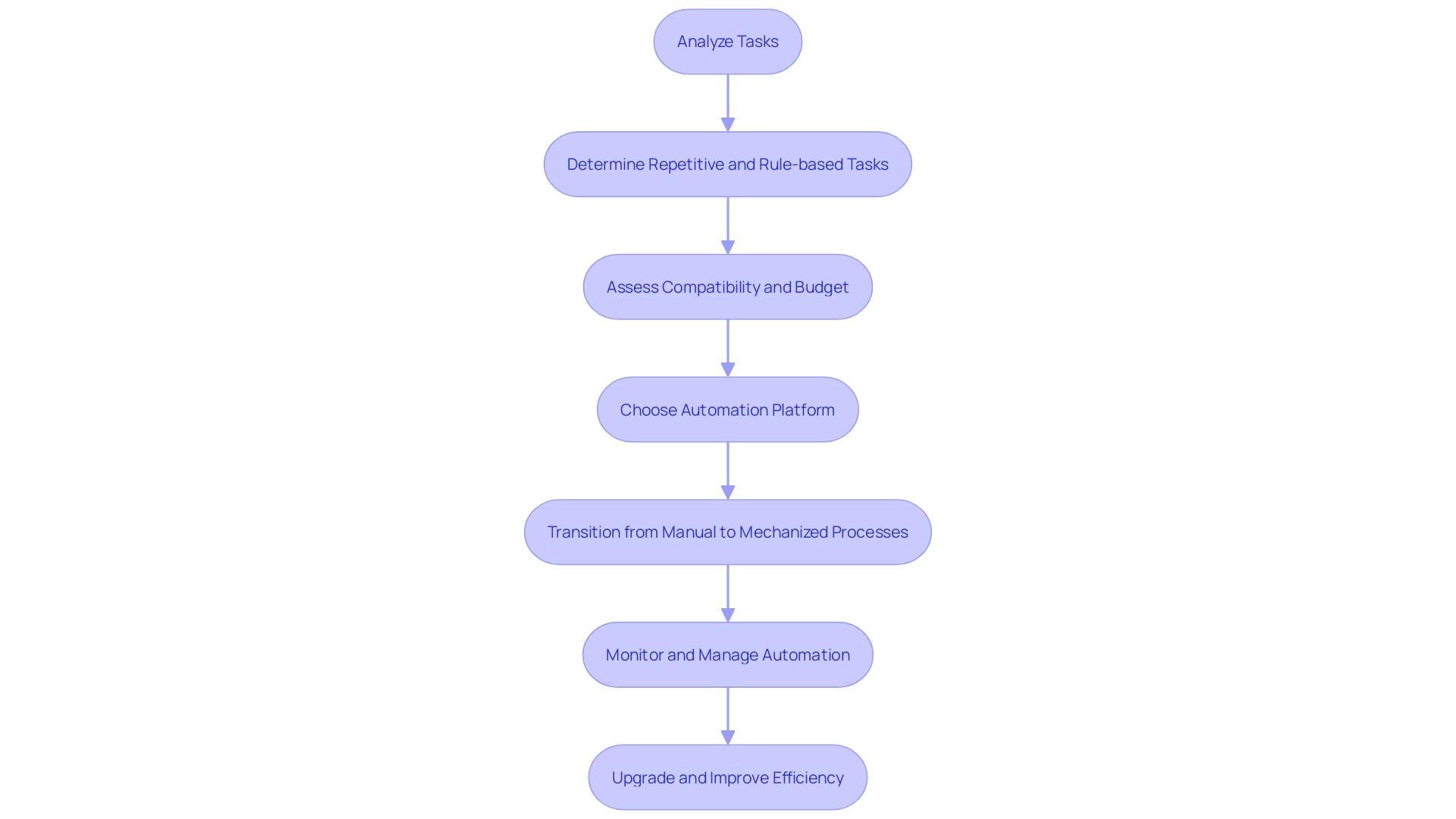
Choosing a Robot Automation Platform
Selecting a suitable Robot Automation platform is vital for the success of initiatives. When evaluating RPA platforms, consider factors such as scalability, ease of use, integration capabilities, security, and vendor support. A platform that scales effectively with your business needs, integrates seamlessly with existing systems, ensures robust security protocols, and offers reliable support can significantly enhance the effectiveness of your automation efforts.
GrayMatter Robotics is at the forefront of transforming manufacturing with AI-driven robotics, crafting smart robotic cells that augment human capabilities in repetitive and ergonomically challenging tasks. Their success emphasizes the significance of choosing a partner whose solutions align with your quality and improvement objectives.
Moreover, at the recent World Robot Conference in Beijing, the display of humanoid robots capable of diverse applications highlighted the rapid advancement in robotics, suggesting an impending era where robots are as ubiquitous as digital assistants are today. This underscores the need for platforms that can adapt to the rapidly evolving technological landscape.
A foundational understanding of your organization’s processes, technology, and people will guide the successful implementation of new technologies. Vision and strategy, along with a comprehensive grasp of existing workflows, are key to realizing the benefits of digital transformation, like integrating digital twins with gantry robots for optimized operations.
Remember to ask important questions before selecting a tool for streamlining processes, such as the intended use case and compatibility with your systems. This clarity assists in choosing a tool that best meets your requirements.
Investing in intelligent technology also yields significant financial benefits, as evidenced by a study showing a 73% revenue growth in overall Net Present Value (NPV) benefit and a 5.4% compound annual growth rate (CAGR) over three years. This emphasizes the measurable returns on investment when implementing mechanization solutions thoughtfully.
To sum up, the appropriate platform for streamlining processes is not only about technology—it’s about discovering a solution that aligns with your vision, enhances your current procedures, and propels your business towards future expansion.
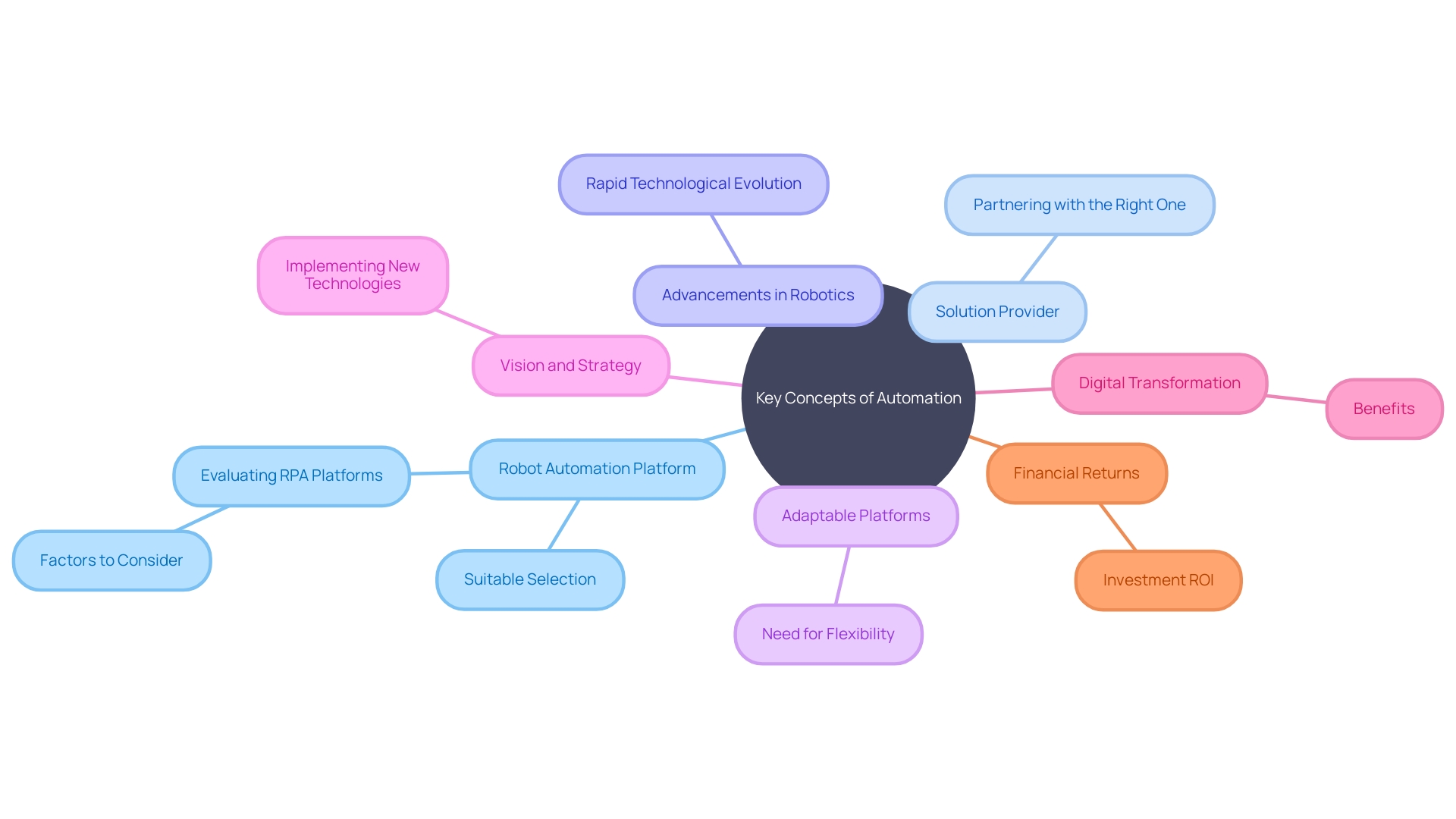
Creating a Proof of Concept
Beginning the process of robotic technology requires a well-thought-out plan, and building a proof of concept (POC) is a vital initial phase. This stage is crucial in evaluating the feasibility and potential benefits of robotic technology within your operations. A detailed POC process should include the selection of processes that are prime candidates for mechanization, meticulously designing an automated workflow that’s both efficient and effective, and a thorough evaluation of its performance.
For example, St. James Winery, a prominent winery with more than 50 years of success, could utilize a POC to assess how robotic technology could improve their vineyard and cellar operations. By successfully executing a POC, businesses like St. James Winery can substantiate the efficacy of robotic technology and proceed with confidence.
The broader market is also recognizing the value of such innovations. According to the Hannover Messe report, there is a growing demand for mobile robotic technology, with applications spanning from e-commerce to healthcare. The development of affordable mobile robots, such as the ReBeL, which is revolutionizing accessibility for small and medium-sized enterprises, is a testament to the transformative power of automation.
To ensure that the POC aligns with the high standards and expectations of stakeholders, acceptance testing is integral. It’s a phase where the system is scrutinized to ascertain its compliance with user requirements and legal regulations, thus safeguarding against potential legal repercussions in regulated industries. Planning and preparation, which involve defining the scope, selecting appropriate tools, and setting up a testing framework, lay the foundation for successful test case and data preparation. This careful procedure is crucial for configuring the environment and managing test data to mirror real-world scenarios as closely as possible.
Mapping and Building the Automation Workflow
After identifying the appropriate processes for streamlining, the subsequent course of action involves carefully designing the workflow. This starts by performing a comprehensive examination and carefully recording every stage of the current workflow, followed by setting up the logic and rules of the system. The creation of an effective workflow is not only about the mechanization itself but also about predicting and planning for possible failures, as observed in the experiences of infrastructure companies like Nuon. They comprehend that every stage, starting from authorizing account entry to deploying applications, can face problems like permission denials, customer interference, or failures, all of which need to be skillfully managed to guarantee a seamless and efficient implementation.
Innovations like Bosch’s solid oxide fuel cell (SOFC) are exemplary, demonstrating how a combination of high electrical efficiency and digital twin technology can optimize performance and facilitate sustainability in energy production. Similarly, workflow mechanization should be envisioned as a robust system that can adapt and evolve. By leveraging cutting-edge tools and platforms, organizations can automate mundane tasks like notifications and permissions management, freeing up valuable human resources for more strategic endeavors. A Zapier report highlights that nearly all workers in smaller businesses routinely perform repetitive tasks, signifying the widespread effect that the use of technology could have on enhancing job satisfaction and operational efficiency.
Moreover, the rapid adoption of platforms like Power Apps, which is now used by over 25 million users monthly, demonstrates the growing appetite for tools that enable seamless collaboration and development. By embracing an integrative approach to workflow management, businesses can establish an environment that is not only favorable for ‘Citizen Developers’ but also for professional developers who desire transparency and control over the source code. The mapping and building of an automation workflow are thus a pivotal step in achieving streamlined operations, and when executed with foresight and strategic planning, it can lead to transformative results for an organization.
Implementing Robot Automation Bots
Deploying Robot Automation bots is more than just setting up automated workflows; it’s about ensuring they mesh perfectly with your existing systems and perform tasks with precision and efficiency. The deployment begins with careful bot configuration, customized to your specific business requirements, and expands to thorough testing to ensure perfect operation.
For example, companies like GrayMatter Robotics are at the forefront, transforming manufacturing through AI-driven robotics that enhance productivity and quality of life. Their method of streamlining highlights the significance of excellence and collaboration in the implementation.
When it comes to testing, it’s akin to the precision and commitment of Last Arrow Manufacturing, a metal fabrication expert, ensuring products meet the desired quality standards. This level of dedication is mirrored in the testing phase of Robot Automation bots, where every scenario is meticulously evaluated.
The deployment process also includes a strategic approach to integration. At a recent ceremony in London that recognized achievements in robotics and technology, it was emphasized that the effectiveness of these processes depends on the collaboration between individuals, machinery, and information. The integration phase ensures that these elements work in harmony, similar to the holistic systems approach advocated by experts.
Furthermore, the significance of human supervision in mechanization cannot be emphasized enough. From the water wheel to AI, history teaches us that while mechanization aims to boost efficiency and productivity, it requires human partnership to maintain stability, as emphasized by the CTO and Co-Founder of Reveille Software.
With an action guide that includes an 11-point blueprint for optimizing intelligent robots, businesses can navigate the complexities of integrating Robot Automation bots. The ongoing increase in workflow adoption, as observed in the latest statistics for 2024, indicates that businesses that embrace this technology can maintain a competitive advantage.
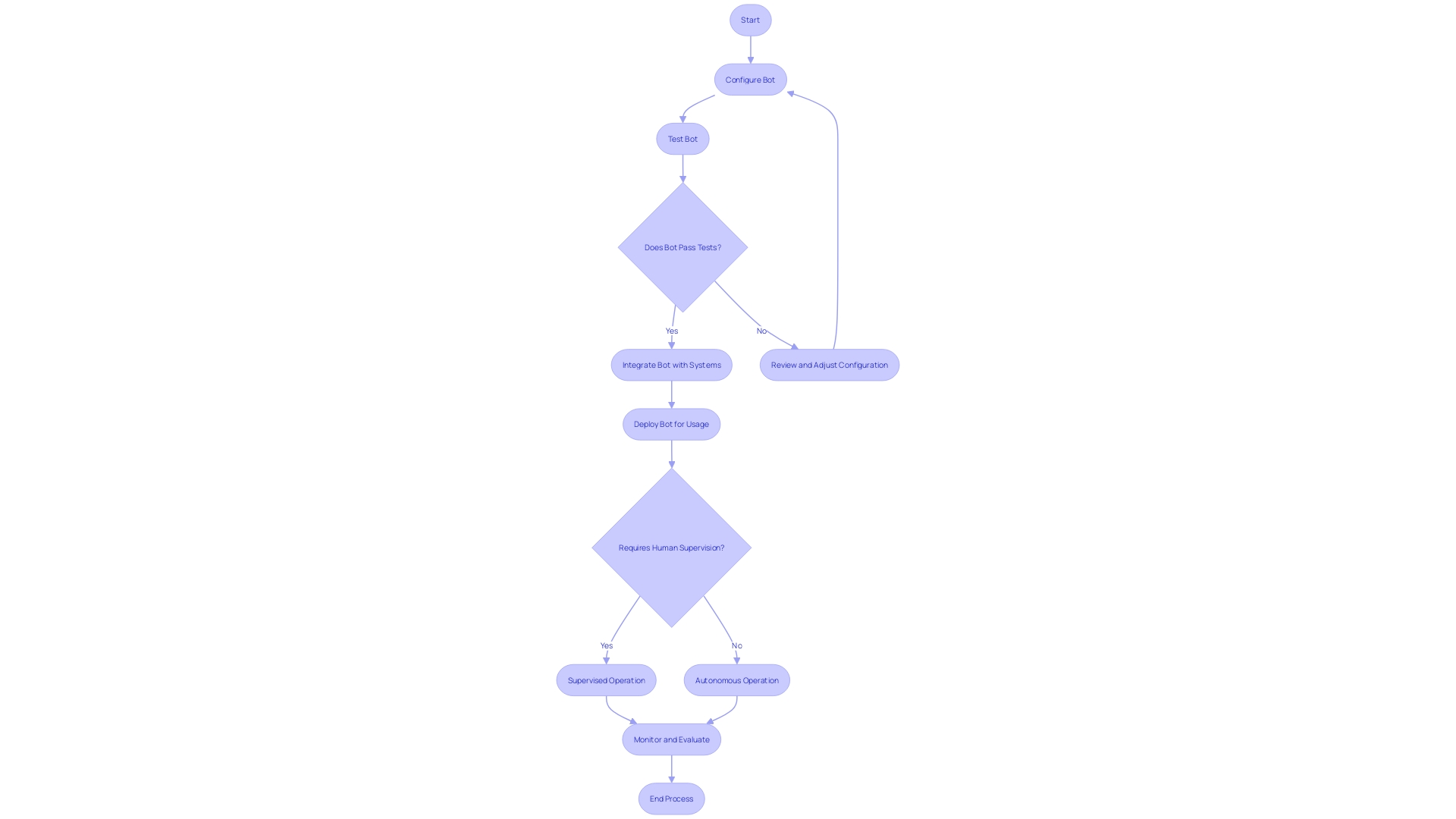
Monitoring and Maintaining Robot Automation Bots
Robotic Process Automation (RPA) bots have revolutionized the way businesses handle routine tasks, allowing for increased accuracy and productivity while saving time and resources. However, the deployment of these bots is only the beginning. Effective bot management is crucial, and this involves diligent monitoring and regular maintenance to ensure they continue performing optimally.
Monitoring RPA bots involves more than just overseeing their day-to-day operations; it requires an in-depth understanding of their performance metrics and the ability to identify and resolve issues promptly. Initiatives like Fortinet’s advanced bot protection service, which can differentiate between malicious and benign bots, underscore the sophistication needed in today’s bot management strategies.
Maintenance, on the other hand, is about ensuring the bots are up-to-date with the latest software updates and security patches. According to a senior mechanical engineering specialist, Ian Gardiner, even though the core technology may remain the same, continuous improvements and updates are essential. This is evident from the challenges faced by his team in keeping product design data updated across departments and partners.
Organizations should also be mindful of the broader operational environment. For instance, as OODA’s team of experts provides advanced intelligence and analysis services, they highlight the importance of being aware of risks and threats in the digital landscape, including those posed by malicious bots.
To preserve the long-term advantages of bot mechanization, it is crucial to have a strong plan in place that involves establishing essential roles and permissions, as demonstrated by the procedure of initializing a CloudFormation template. This is a foundational step in deploying bots that are secure and have the necessary access to perform their tasks.
With nearly half of all internet traffic being bot-generated, and a significant portion of that being malicious, it’s clear that the stakes are high. This is supported by the insights from the State of the survey for automation professionals, which indicates that the field is quickly evolving, with a growing need for skilled professionals who can navigate the complexities of AI and RPA.
In summary, the ongoing success of RPA bots in an organization is contingent on proactive monitoring, timely maintenance, and a keen awareness of the digital ecosystem. By adopting these practices, businesses can maintain and improve the advantages of technological advancement well into the future.
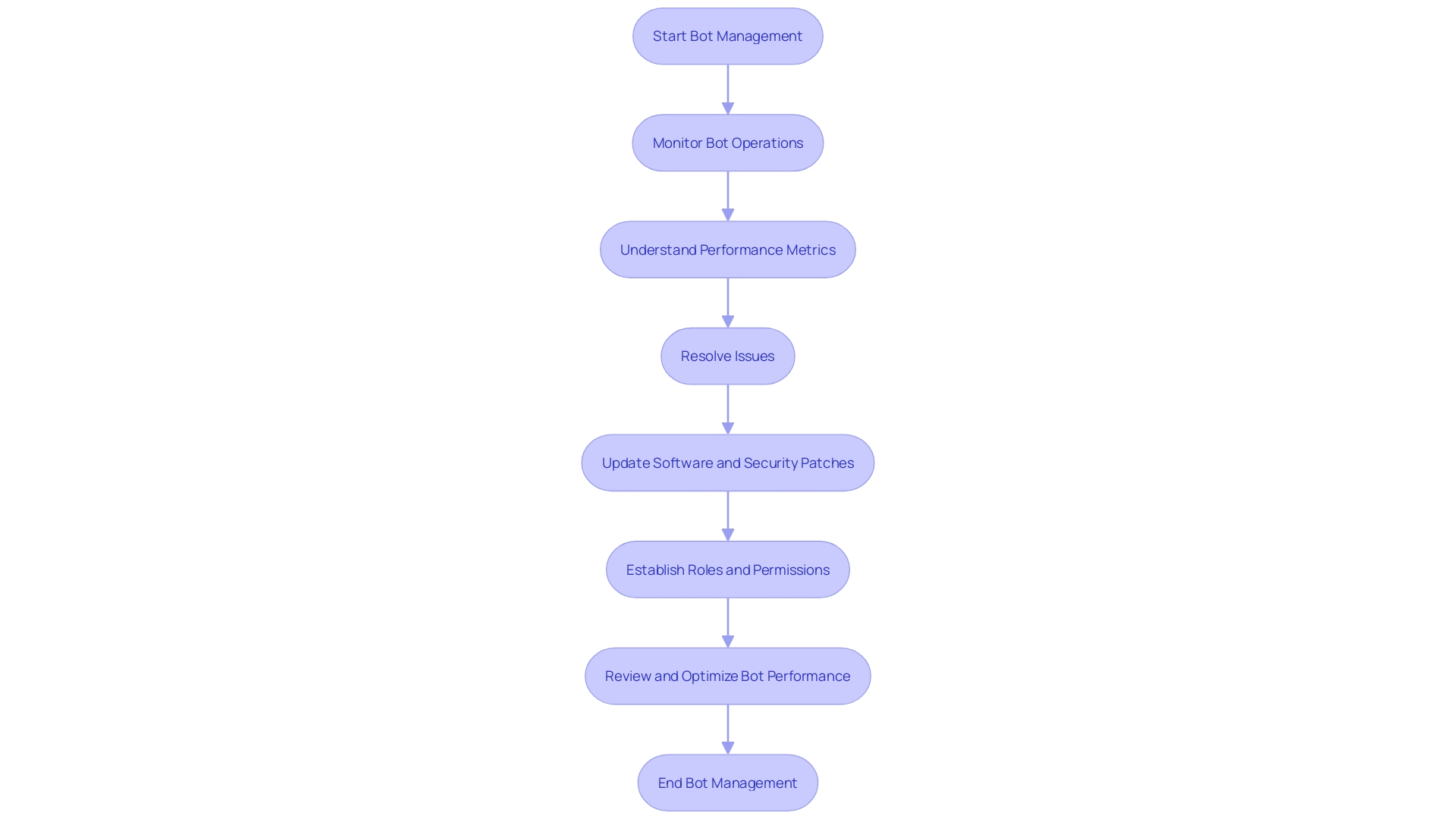
Advanced Robot Automation Techniques
Embracing the cutting edge of mechanization, we explore the realm of cognitive mechanization, intelligent mechanization, and the incorporation of machine learning into robotic systems. These avant-garde techniques are not merely add-ons; they are transformative forces for businesses. Cognitive brings the power of human-like reasoning to handle unstructured data, intelligent process orchestrates complex workflows, and machine learning yields insights from data, leading to astute decisions. The fusion of robotics with these technologies propels organizations into a realm of heightened efficiency and innovation.
As demonstrated by GrayMatter Robotics, whose AI-driven solutions are shaping the future of manufacturing, the implementation of intelligent technology is truly profound. Furthermore, Last Arrow Manufacturing’s ten-year metal fabrication experience demonstrates that even specialized sectors can greatly profit from incorporating advanced technology.
The recent unveiling of Omron’s iCR robot, as mentioned by company president Olivier Welker, is evidence of the progress being made in industrial technology. The iCR is set to redefine manufacturing standards globally, underscoring the significance of continuous innovation.
To leverage the complete potential of intelligent technology, companies should consider developing a strong collection of tools to support its growth. Initiating with simpler tasks and scaling up to more complex workflows is a strategic approach. Continuous monitoring and documentation of results are critical for measuring success and guiding future endeavors. In the end, intelligent automation is equivalent to digital transformation, and its careful implementation can result in significant improvements in efficiency, gains, and more informed decision-making.
In the current landscape, organizations like Pieces exemplify the augmentation and enhancement model by equipping developers with tools that boost their cross-functional capabilities. This approach, as discussed by Tsavo Knott, enhances productivity without replacing the human element. It’s an era where the synergy of robotics, AI, and human ingenuity is unlocking untapped potential across various sectors.
Integration of Artificial Intelligence and Machine Learning in Robot Automation
The advent of AI and ML in the realm of Robot Automation heralds a transformative era for industries, imbuing robots with cognitive capabilities, predictive analytics, and adaptive learning faculties. These advancements are not merely incremental; they represent a seismic shift in operational potential. For instance, GrayMatter Robotics is leveraging AI to refine manufacturing processes, aiming to elevate human productivity while simultaneously enhancing life quality. Their proprietary AI technology is directed towards crafting a future where robotics seamlessly integrate into manufacturing, ensuring products meet the highest standards of quality.
Meanwhile, groundbreaking research by KIMM’s Chang-hyun Kim and his team has yielded AI applications for robot work that simplify adoption in manufacturing, with a current focus on electronic component production. Their AI solution interprets user commands through Large Language Models and virtual environments, facilitating task execution by robots. This technology promises to revolutionize task sequence and motion generation, allowing for intuitive voice or text command recognition.
In practical terms, the range of intelligent mechanization can be divided into four separate categories: AI-enhanced, independent, self-governing, and cognitive mechanisms. Each category delineates the level of sophistication in Ai’s interaction with human activities and environments. The lines between these categories may blur as the technology progresses, reflecting the dynamic evolution of intelligent automation.
Supporting this technological march, statistics reveal that AI-augmented systems might display autonomous traits under certain conditions, underscoring the fluid nature of these classifications. Furthermore, an AI algorithm’s effectiveness hinges on three pillars: the capacity to measure, discerning valuable data from the deluge available, and processing multiple inputs simultaneously. This necessitates a judicious selection of data, focusing on the most pertinent information to the decision at hand and the minimum necessary to optimize AI outputs.
In essence, AI’s role in business is transformational, not just as a tool, but as a revolution. As companies harness AI to execute independent tasks, they can redirect focus on more critical functions, boosting productivity, and driving sales growth. In this context, touch-sensitive robotics, a discovery attributed to Maged Iskandar, is an exemplary case where force-torque sensors paired with machine learning empower robots to interpret various tension forms, enhancing their touch sensitivity.
This is not the future; it is the present. Brands and businesses are already implementing AI to lead industry progress. St. James Winery’s storied tradition of wine-making excellence illustrates the practical benefits of mechanization. With their dedication to excellence, they serve as evidence of the benefits of embracing intelligent technology. Ready to start a journey of mechanization? The advancements in AI and ML are paving the way for smarter, more efficient, and profoundly transformative operations in Robot Automation.
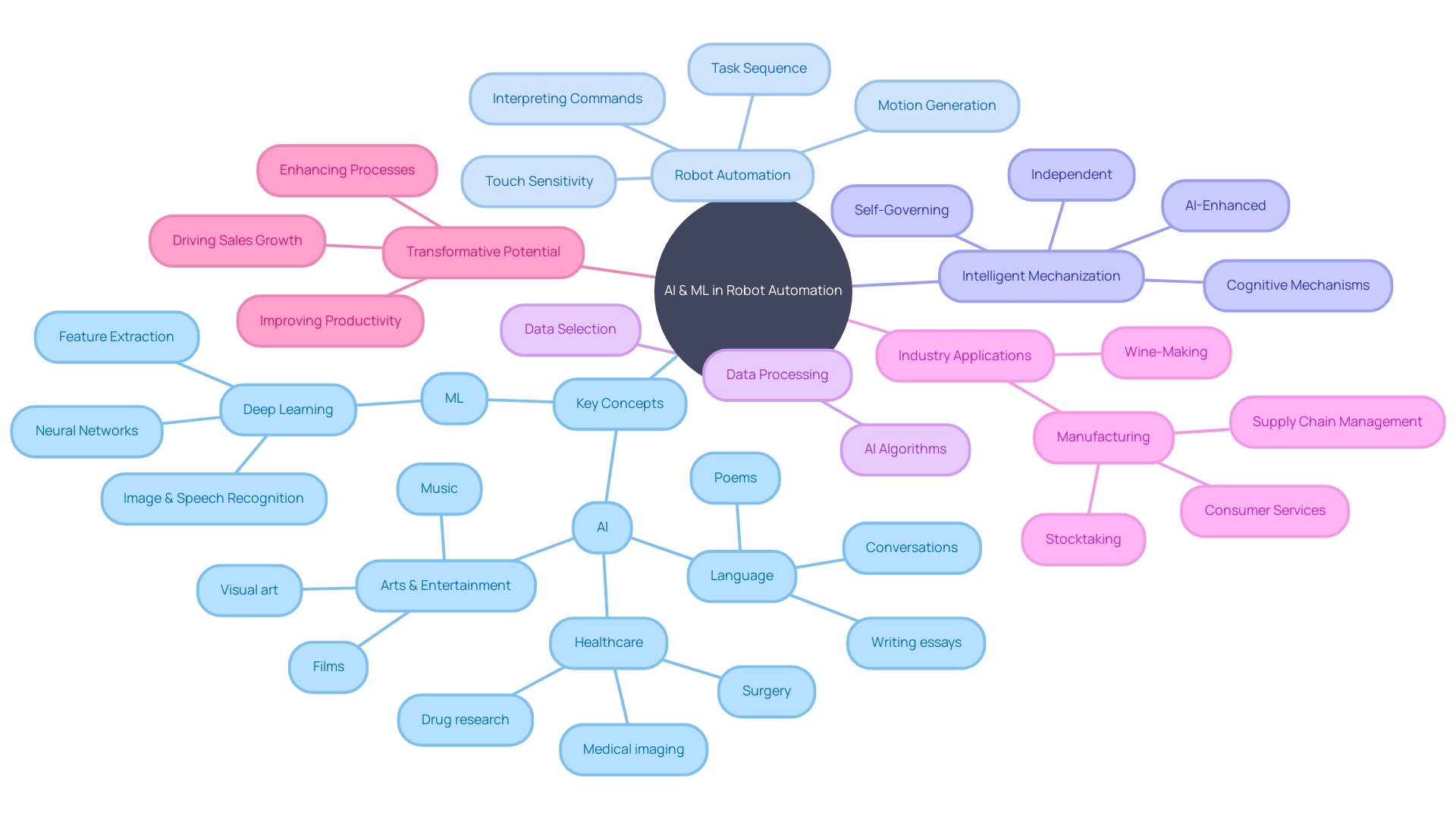
Use Cases of Robot Automation in Various Industries
Robotic technology is transforming a wide range of sectors by enhancing operations and efficiency. In banking, powerful AI is set to impact 73% of employee tasks, with a significant portion available for mechanization, promising a transformative impact on productivity. In healthcare, precision and consistency are paramount, and robotics ensures these qualities are upheld in every procedure. Manufacturing benefits from both the meticulous precision and the ability to maintain unfaltering pace, leading to a marked increase in production capabilities without sacrificing quality.
The field of hospitality, as exemplified by the Louvre Hotels Group, has experienced impressive efficiency improvements with the implementation of robotic solutions in managing rate code maintenance, resulting in saving countless hours each month and showcasing the scalability of automated technology. Logistics, as well, is a field enjoying the benefits of mechanization, with streamlined procedures and improved tracking abilities.
Even in construction, a sector traditionally slow to adopt new technologies, innovation is taking root. With the likes of ABB Robotics and Porsche Consulting spearheading a pilot project for automated housing manufacturing, the sector is set to address labor shortages and contribute to sustainable building practices. By embracing robotic technology, operations in these industries are not just improving their current procedures but are also paving the way for a more efficient and innovative future.
Best Practices for Implementing Robot Automation
Successfully implementing robotic technology hinges on adhering to established best practices that pave the way for a seamless and efficacious journey. These best practices involve thorough process evaluation to ensure the proper fit, extensive stakeholder engagement to encourage support, strong change management to navigate the transition, and a dedication to continuous improvement, allowing for the progression of processes over time.
GrayMatter Robotics exemplifies these principles, leveraging AI to enhance human productivity and quality of life in the manufacturing sector. Their emphasis on developing robotics and exclusive AI solutions highlights the significance of selecting the appropriate partner and solutions for a successful outcome.
Moreover, as the International Federation of Robotics highlights, we are amid a transformative era marked by global events reshaping manufacturing and logistics. With AI advancements, robots are now capable of learning from experience and operating in dynamic environments, reinforcing the role of AI in empowering autonomous systems.
Businesses must, therefore, clarify their specific needs and establish guiding principles for selecting appropriate technologies. This involves understanding the nuances of different technologies and evaluating various scenarios, including potential for future growth.
Acceptance testing also plays a crucial role, offering a user-centric perspective to ensure the automation meets the expected real-world requirements. This step is critical to maintain compliance with legal and regulatory standards, particularly in industries such as healthcare and finance.
Statistics on autonomous capabilities of robots, like those provided by AMRs, reveal the complexity of developing systems that can navigate and collaborate effectively in dynamic spaces like warehouses. This complexity is compounded by the need for robots to interact safely with humans and integrate with IoT devices.
Additionally, the findings from a worldwide survey of 1,639 professionals in the field of automated processes carried out by UiPath in early 2023 demonstrate an increasing curiosity and preparedness to incorporate AI into the labor force. Such insights are invaluable for hiring managers and CoE leaders looking to navigate the complexities of technological advancements in the workplace.
By embracing these best practices and insights, organizations can optimize their initiatives, ensuring that their journey towards efficiency and innovation is both sustainable and aligned with the evolving landscape of AI and robotics.
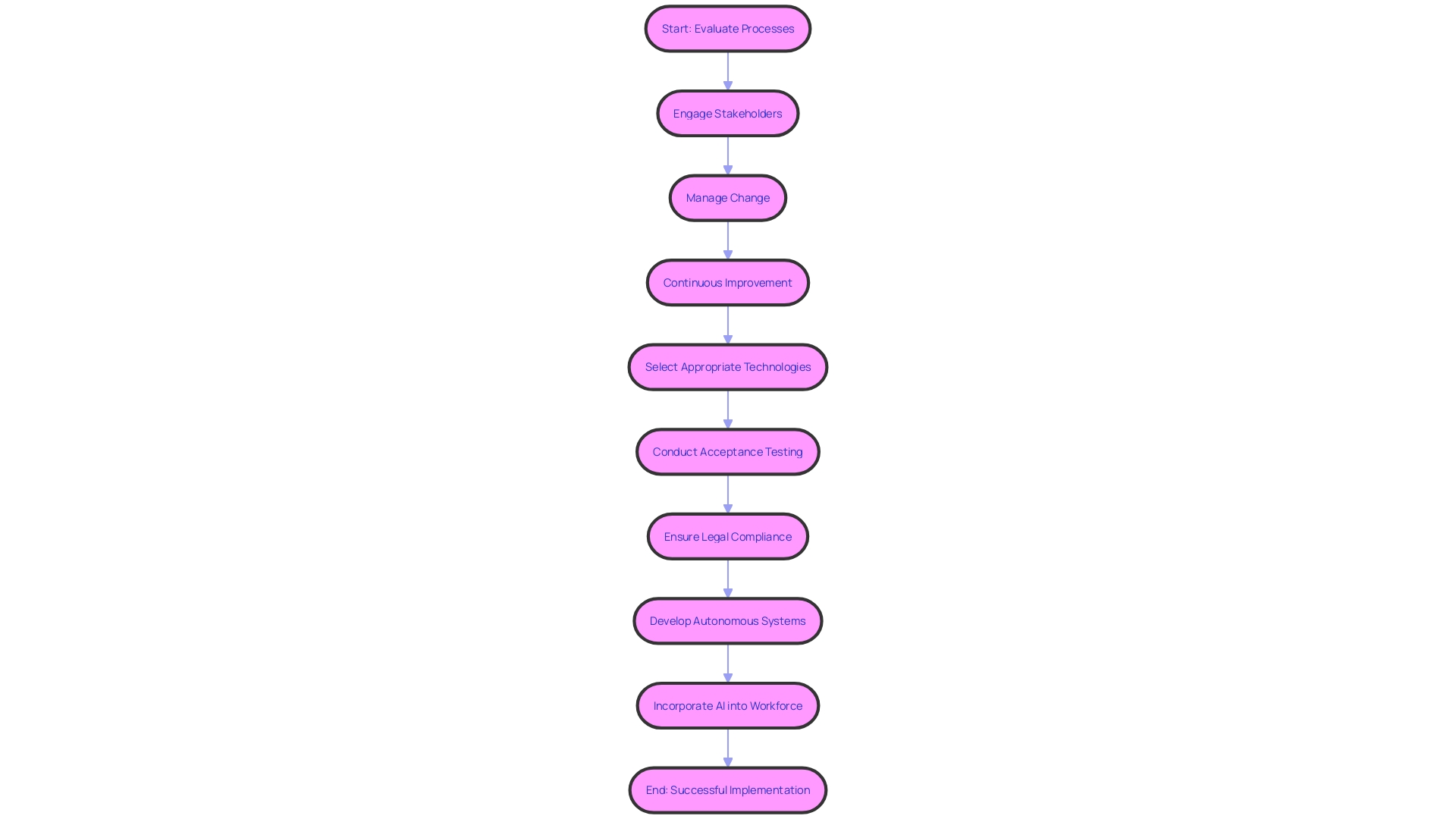
Common Challenges and Solutions in Robot Automation Implementation
While the incorporation of robotic technology into sectors presents revolutionary potential, it’s crucial to recognize the associated difficulties. These include adapting to the evolving technological landscape, addressing data security concerns, and ensuring scalability to meet future demands. In the journey towards successful mechanization, companies like Millennium Recycling have shown the effectiveness of advanced single-stream processes in expanding their operations and staying ahead in the recycling sector. Similarly, GrayMatter Robotics’ AI-driven solutions exemplify the synergy between human ingenuity and robotic precision, enhancing productivity and quality of life.
A McKinsey report highlights that businesses, particularly SMEs, are anticipated to allocate more than 25% of their capital towards the implementation of automated systems in the coming years, indicating a definite move towards embracing these technologies. Despite initial hesitance, the trend is shifting, as demonstrated by a 54% increase in the installation of new robots in the UK in 2022 compared to 2015.
The industrial landscape has always evolved in an ‘S-curve’ pattern, beginning with a learning phase characterized by experimentation. This progresses into a deployment phase where foundational technologies are applied, leading to an optimization phase where best practices are established and costs stabilize. This trend can be seen in the implementation of mechanization across various sectors.
In the context of the fourth industrial revolution, the UK’s position in robot density, standing at 25th globally with 98 robots per 10,000 workers, contrasts with Germany’s 415. This void emphasizes the crucial requirement for sectors to adopt mechanization to improve efficiency and sustain competitiveness.
By utilizing the knowledge from case studies, industry news, and expert analysis, businesses can navigate the intricacies of implementing automated processes. Dealing with these challenges necessitates a well-planned strategy, fostering collaborations with solution providers, and staying updated on the latest advancements in AI and technology.
Measuring the Success of Robot Automation Initiatives
Assessing the effectiveness of robotic technology is more than a matter of tracking metrics; it’s a strategic approach to harvesting tangible benefits. Millennium Recycling, with its cutting-edge single-stream technology, serves as a testament to the transformative power of mechanization, making recycling simpler and widely accessible. Similarly, RobosizeME’s partnership with Louvre Hotels Group resulted in a remarkable boost in operational efficiency, saving hundreds of hours per month in rate code maintenance alone. These examples highlight the quantifiable results of well-implemented mechanization.
Key performance indicators (KPIs) central to this evaluation include cost savings and error reduction, which are straightforward metrics of success. Nevertheless, the evaluation also encompasses the examination of process cycle times and employee productivity, offering a thorough comprehension of the influence of mechanization. When St. James Winery embraced technological advancements, it wasn’t just about the bottom line; it was about reinforcing its legacy as a leading winery, where quality is paramount.
Incorporating these metrics requires a nuanced approach, akin to the meticulousness of Tony Stark fine-tuning his Iron Man suit. It requires a careful evaluation of use cases within the Power Platform, where the frequency of automated executions and the anticipation of peak demand periods are just as important as the potential monetary value derived from automating processes. This careful planning is backed by Forrester’s Total Economic Impact methodology, which has demonstrated a substantial increase in revenue and CAGR for companies investing in intelligent technology.
These insights are complemented by the words of Elon Musk, who emphasizes the significance of questioning every requirement to ensure that mechanization initiatives are as effective as possible. This philosophy aligns with current trends in mechanization, where space and time constraints of the physical world meet the boundless potential of digital innovation. As the field of mechanization keeps on advancing, it’s clear that a strategic, data-driven method for measuring success is not just advantageous but necessary for any organization looking to stay ahead in the industry.
Future Trends in Robot Automation and Automation
Robotics and mechanization are at the forefront of industrial and technological advancement. The current trends suggest a future in which hyperautomation, intelligent automated systems, and collaborative human-robot interactions become the standard, working together to improve productivity and operational efficiencies.
Recent case studies highlight the practical impacts of these innovations. GrayMatter Robotics is reshaping the manufacturing landscape with AI-driven robotic solutions that promise enhanced human productivity and higher quality end-products. In the same way, the partnership between RobosizeME and Louvre Hotels Group demonstrates the power of automated processes in the hospitality sector, resulting in significant time savings every month through advanced rate code maintenance technology.
The 2024 World Robot Conference in Beijing was a testament to the sector’s burgeoning growth, with humanoid robots poised to become ubiquitous in fields ranging from manufacturing to entertainment. Embodied AI is set to revolutionize our daily lives, and the fervor surrounding it is likened to a new space race, with significant investments pouring in.
One of the key trends in robotics is the integration of the Industrial Internet of Things (IIoT) with articulated robots, which are known for their flexibility and precision. IIoT enhances these robots’ capabilities, allowing for more efficient operations and predictive maintenance through real-time data analysis.
Moreover, the global industrial robotics market is expected to exceed 45 billion USD by 2028. This growth is fueled by AI, machine learning, and sensor technology advances, coupled with an increasing demand for sustainable manufacturing solutions to counteract global labor shortages.
The classification of intelligent mechanisms differentiates them into AI-augmented, self-governing, self-regulating, and cognitive mechanisms, each exemplifying different degrees of interaction with human activity. These systems are revolutionizing industries by offering efficiency, cost savings, and enhanced safety, although integration complexity and adaptability challenges remain.
Overall, by understanding and adopting these emerging trends, companies can leverage robotics and automation to secure a competitive edge and foster a more dynamic and innovative operational framework.
Conclusion
In conclusion, robotic process automation (RPA) offers increased efficiency and precision, transforming businesses across industries. Key concepts include selecting the right automation platform, creating a proof of concept, and mapping the automation workflow. It’s crucial to choose reliable partners and solutions that align with goals.
Implementing robot automation involves meticulous configuration, comprehensive testing, and strategic integration. Monitoring and maintaining bots ensure optimal performance. Advanced techniques like cognitive automation and machine learning integration enhance efficiency and innovation.
Robot automation has use cases in various industries, optimizing operations and increasing productivity. Best practices include thorough process evaluation, stakeholder engagement, change management, and continuous improvement.
Measuring success involves tracking metrics like cost savings, error reduction, and employee productivity. Future trends include hyperautomation, intelligent automation, and collaborative human-robot interactions.
By understanding these trends, companies can leverage robotics and automation for a competitive edge. The transformative power of automation shapes the future of work, and businesses that embrace it gain significant advantages.
Ready to streamline your workflows and enhance efficiency? Implement robot automation today!

